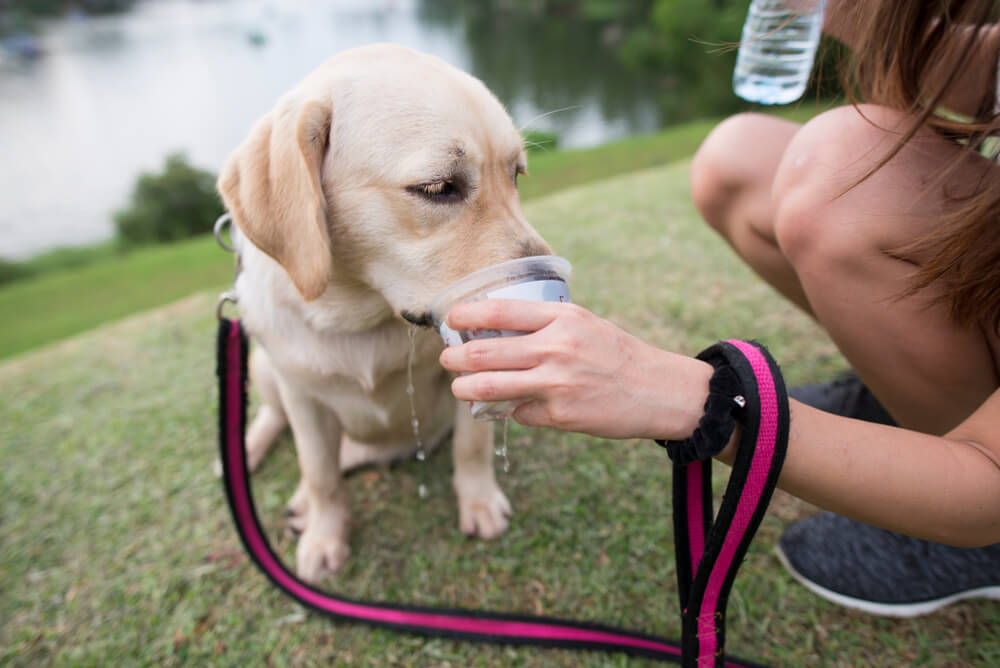
While outdoor summer fun is best enjoyed with our furry family members, there is no question that pets and heat do not go hand-in-hand. From hot cars to overexertion, like people, pets are at risk for heat-related injuries. But, because of their thick fur coats, certain facial conformations, and other factors such as weight and age, many pets are at increased risk for overheating, and require special attention during the warm summer months. When temperatures rise outdoors, keep the following in mind to help prevent heatstroke, paw pad burns, and other common hot weather ailments.
Create a heat safety kit for your pets
Many pet owners have first aid kits in their home for the inevitable bump, bruise, or bee sting, but a separate kit for pet injuries is a wise idea, especially once summer rolls around and pets spend more time outdoors, romping around in the heat. Consider stocking a tote bag or small tub with basic heat safety items that you can toss in your car or backpack whenever you’re planning an outing with your four-legged friends. Taking the time and effort to prepare a kit with potentially life-saving items is a small price to pay for your pet’s safety. Here is a list of essentials:
- Portable containers of water — The most important item for your pet in the warmer months is an abundance of fresh, cool—never cold—water. This is not only important for staying hydrated, but also for extra help to cool down pets who overheat. Unless you will be close to a lake, river, or other source of fresh water, consider bringing a couple of gallons, if you have space.
- Collapsible bowls — While a bowl is not a life-saving item, an abundance of water is not helpful if your pet has nothing to drink from. Collapsible silicone bowls are lightweight and easy to pack, so we recommend bringing one or two along.
- Thermometer — If you suspect your pet is overheating, a thermometer is your most important diagnostic tool. Choose one that can be used rectally, as this is the best way to measure your pet’s core body temperature. For dogs and cats, the normal temperature range is between 99.5 and 102.5.
- Towels — These aren’t meant to dry off your pets when they finish a swim session — although, they can be used for that, too. Rather, towels and other absorbent materials can be soaked with cool water to help cool down your pet in the event of heat exhaustion or heatstroke.
- Portable fan — When you combine airflow and moisture, evaporative cooling occurs, which is a great way to reduce your pet’s body temperature.
- Bandaging basics — When it comes to summer safety and pets, heatstroke is the most serious concern, but hot pavements can wreak havoc on sensitive paw pads. The best way to avoid paw pad burns is to avoid hot pavement, but keep some basic bandaging material on hand in case your pet is injured.
- Pet-safe sunscreen — While not common, pets can suffer from painful sunburn, especially those with light-colored, short, or thin hair coats. Areas such as the nose, muzzle, and inguinal regions are at-risk as well, so consider keeping a pet-safe sunscreen on hand. Generally, most baby-safe sunscreens are fine for pets, but avoid any products with zinc.
Hone your veterinary heat safety skills
Knowledge is power, and knowing how to respond to a heat-related injury could save your pet’s life. Here are some basics on heat safety first aid:
- Heat exhaustion or heatstroke — If your pet is overheating, you’ll likely notice increased panting, drooling, and restless behavior as they try to find a cool, shady spot to rest. In severe cases, you may see vomiting, diarrhea, or bright red gums. In any case, grab a hose or container of cool water, and pour it gently over your pet, wiping away the water to help release the excess heat. Encourage your pet to drink water. Check your pet’s temperature, rectally. In the meantime, contact Towne Centre Animal Hospital or your nearest veterinary emergency clinic for further advice. If your pet requires veterinary attention, grab your towels and douse them in cool water, wrapping them around your pet’s abdomen and head, save for the nose and mouth, to help release excess heat. Use your portable fan to encourage evaporation while you transport your pet to the nearest veterinary clinic.
- Paw pad burns — If your pet suffers a painful burn from stepping on hot pavement, gently rinse the area of any debris with clean water and allow to dry. Place a gauze square or Telfa pad on the burn, gently wrap the paw with gauze wrap or other bandage material, and secure the wrap loosely but firmly. Wrapping a limb too tightly may lead to vasoconstriction and other complications, so home-made bandaging should be a temporary solution until you can arrive at Towne Centre Animal Hospital. Refrain from using creams or products on the burn area, unless our veterinary team advises you otherwise.
- Sunburn — Also known as solar dermatitis, sunburns are painful and uncomfortable. While not a common concern in our furry friends, sunburns can vary greatly in intensity, so contact our veterinary team if you suspect your pet has been burned.

For more information on veterinary first aid basics, visit the American Veterinary Medical Association (AVMA).
Of course, our hospital team is here for all your pet’s veterinary needs. If you are ever uncertain how to treat your pet, or have additional questions about heat safety, contact us here.
